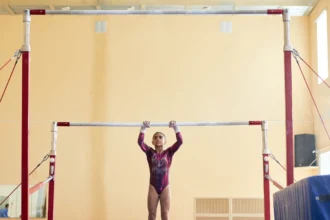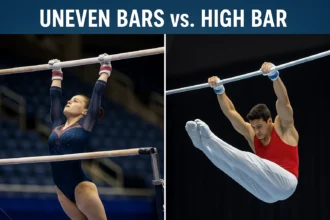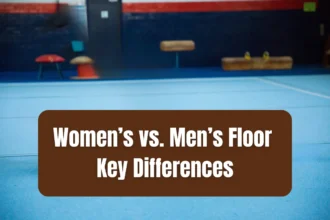Competing at State, Regional, or even National Championships is a major milestone for gymnasts in the United States. Each level has clear steps, score requirements, and competition structures that determine who advances.
Step 1: Compete in Sanctioned Meets
Before any gymnast can qualify for a championship-level meet, they must first compete at sanctioned meets. These are official competitions approved by USA Gymnastics where certified judges evaluate routines using the appropriate Code of Points.
Sanctioned meets provide:
- Official scores that count toward advancement
- Mobility opportunities (i.e., moving up levels)
- Eligibility for championship qualification
💡 Only scores from sanctioned meets can be used to qualify for State, Regionals, or Nationals.
State Meets: The First Major Goal
Qualifying for State Meets is the first major competitive milestone in most gymnasts’ seasons. Each state sets its own rules, but common patterns and score ranges appear across the country.
Qualification Chart by Program (2025 Estimates)
| Athlete Path | Typical AA Range* | IES Range* | Notes |
|---|---|---|---|
| Levels 1–5 (Compulsory) | 32.00 – 34.50 | — | Oregon requires 32.00 AA; Northern California sets 34.50 AA |
| Levels 6–10 (Optional) | 33.00 – 34.00 | 8.90 – 9.00 | NJ uses 33.00 AA and 8.90 IES for Levels 9 and 10 |
| Xcel (All Divisions) | 32.00 – 33.00 | 8.50 – 8.75 | Varies by state/division; Sapphire division often requires 1.0 more AA |
*Exact numbers come from each state handbook. These ranges reflect the most common values for the 2025 season.
Where to Qualify
To qualify, gymnasts must usually attend at least one designated sectional or qualifier meet, where they aim to hit the required AA score. These meets are typically scheduled throughout the regular season and are specifically meant to provide fair chances to qualify.
Sectional Waivers
In some states, sectionals are not mandatory. If there’s room at States, gymnasts may be allowed to enter directly, especially if they’ve already competed in another state or have extenuating circumstances. Check your state’s guidelines, as this varies widely.
Injury Petitions
If a gymnast is injured and cannot participate in a qualifier meet, they may still qualify for State through a petition process. Most states require:
- Medical documentation from a licensed physician
- A prior AA score that is 1.0 point higher than the current minimum
This option gives athletes a safety net while keeping competition standards fair.
IES (Individual Event Specialist) Track
For Levels 6–10 and Xcel, some states allow gymnasts to qualify for State on just one event. This is called IES qualification and is especially helpful for:
- Athletes returning from injury
- Gymnasts focusing on a single apparatus
- Those who specialize in one standout event
IES score requirements are typically higher than AA cutoffs.
Source: usagnj.com, USA Gymnastics Region 8
Regional Meets: Stepping Up
Once a gymnast competes at the State level, the next progression is Regionals. These meets bring together top athletes from multiple states within the same USA Gymnastics region. There are eight regions in total, each with its own qualification rules and scores.
To qualify for Regionals, gymnasts must:
- Compete All-Around (AA) at State Championships
- Have at least three sanctioned AA scores for the season (including the State meet)
This ensures athletes are consistent, seasoned competitors—not just peaking at one meet.
Qualification Criteria by Level:
Levels 6–8: Each region sets its own AA score cutoff, usually around 33.00–35.00. Spots are often filled by top AA finishers from each age division at State. Some regions do not allow petitions for Levels 6–8. This means gymnasts must meet all score and participation requirements directly.
Levels 9–10: Must qualify at State with a minimum AA (often 34.00–35.00).
Xcel Program
The Xcel Program provides a more flexible but still competitive path to Regionals.
Common Xcel Regional Requirements:
- All-Around Score: Typically 34.00–35.00 AA
- Event Specialist Option: Some regions allow entry with 8.5–9.0 on a single event
- Percent-of-Percent System: Each state receives a set number of regional spots based on how many athletes they had at State
- Graduating Seniors: Often qualify automatically just by competing at State (region-dependent)
Sources: USAG Region 2, Region 7 Women’s Gymnastics, USA Gymnastics Region 8
| Level / Division | How to Qualify for Regionals |
|---|---|
| Level 6–8 | AA at State + 3 sanctioned AA scores + meet cutoff (~33–35) |
| Level 9–10 | AA at State + meet regional score (~34–35); petitions allowed |
| Xcel Gold–Diamond | AA ≥34–35 OR event score (e.g., 9.0); based on placement and state quota |
National Meets: The Top Tier
The final and most prestigious step in the USAG Development Program is qualifying for a National Meet. These include the Level 9 Easterns/Westerns and the Level 10 Development Program Nationals (formerly J.O. Nationals).
Level 9: Easterns and Westerns
USA Gymnastics divides the country into two major national meets at Level 9:
- Easterns: Regions 5, 6, 7, 8
- Westerns: Regions 1, 2, 3, 4
Qualification Process
- Gymnasts qualify through Level 9 Regionals
- Must place in the top 7 All-Around within their age group
- A minimum AA score of 34.00 or higher is typically required
Age groups and qualification allotments are set annually by USA Gymnastics.
Level 10: Junior Olympic Nationals (DP Nationals)
Level 10 athletes aim for the prestigious Development Program Nationals, where the top gymnasts in the country face off.
How to Qualify
- Top 7 AA finishers per age group at Level 10 Regionals qualify
- A minimum AA score of 35.00 or higher is usually required
- High-scoring athletes who don’t make the top 7 may be named:
- All-Stars (for team scores)
- Alternates, in case of injury or withdrawal
Petitions are accepted for injury or illness with proper paperwork and qualifying past scores.
Sources: Region 4 Gymnastics, Wikipedia
Xcel Program: No Nationals (Yet)
Unlike the Development Program, the Xcel Program currently does not include a national championship under USA Gymnastics.
Unlike the Development Program, the Xcel Program does not currently have a National Championship. However, top athletes can still compete in prestigious Regional Invitationals hosted by individual regions.
Key Notes:
- Only Gold, Platinum, and Diamond gymnasts are eligible for Regionals
- No official Nationals under USA Gymnastics as of the 2025 season
- Some regions offer showcase-style postseason events to honor top Xcel athletes
Sources: usagym.org, Region 8 Gymnastics
National Qualification Summary
| Level / Meet | How to Qualify |
|---|---|
| Level 9 – Easterns/Westerns | Top 7 AA per age group at Regionals (min ~34.00 AA) |
| Level 10 – DP Nationals | Top 7 AA per age group at Regionals (min ~35.00 AA); All-Stars & Alternates |
| Xcel – Nationals | Not currently offered; regional invitationals only |
In Summary
Advancing from State to Regionals to Nationals in gymnastics is a step-by-step journey, grounded in consistent scoring, official meets, and performance under pressure.
Here’s what every gymnast should focus on:
- Compete in sanctioned meets and build qualifying scores early in the season
- Track All-Around results to make sure you’re on pace
- Understand your state and regional rules—they’re not always the same!
- Work with your coach to choose the right competitions and plan ahead
knowing the qualification process gives you the power to plan, improve, and succeed.












